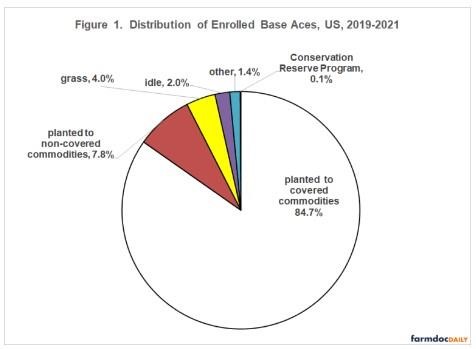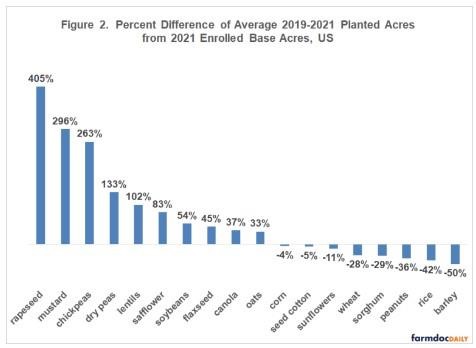By Carl Zulauf
Department of Agricultural, Environmental and Development Economics
Ohio State University
Nick Paulson and Gary Schnitkey et.al
Department of Agricultural and Consumer Economics
University of Illinois
Since the 1996 farm bill, the US farm safety net has given farmers the freedom to not plant program base acres and to plant a crop’s base acres to another crop, with a few restrictions related to fruits and vegetables. This article documents that planting flexibility has become an important feature of US farming and its safety net.
Base Acre Decisions
According to data supplied by USDA, FSA (US Department of Agriculture, Farm Service Agency); during the 2018 farm bill farmers have, on average, planted covered commodities on 85% or 220 million out of 259 million base acres enrolled in commodity programs (see Figure 1). This high of a share is not surprising since covered commodities include the large acreage US field crops. Non-program commodities were planted on 8% (20 million) of enrolled base acres while 4% (10 million) were in grass and 2% (5 million) were idle.

Covered Commodity Decisions
For most individual program commodities, planted and base acres diverge considerably (see Data Note). Only for corn, seed cotton, and sunflowers are average acres planted under the 2018 farm bill within 25% of base acres enrolled in crop year 2021 commodity programs. Planted acres are more than twice base acres for rapeseed, mustard, chickpeas, dry peas, and lentils; and are at least 25% less than base acres for wheat, sorghum, peanuts, rice, and barley. In terms of number of acres, the two extreme differences are 18 million fewer planted than base acres for wheat and 29 million more planted than base acres for soybeans. 2021 base acres are from the ARC/PLC program data file maintained by USDA, FSA while planted acres for 2019 – 2021 are from the Quick Stats data file maintained by USDA, NASS (National Agricultural Statistical Service).

Summary Observations
Planting flexibility has become an important feature of US farming and its safety net. For only three covered program commodities (corn, seed cotton, sunflowers) are planted acres within 25% of base acres.
Farmers have taken advantage of planting flexibility to adjust planted acres to changing private market returns across crops. For example, since 1996, acres of the two largest acreage US field crops, corn and soybeans, have increased by over 10 million. In contrast, acres of the third largest field crop, wheat, have declined by over 20 million.
Given dynamic supply and demand for crops, planting flexibility is a desired farm policy feature and important to keeping US agriculture competitive.
Source : illinois.edu